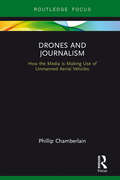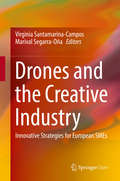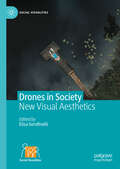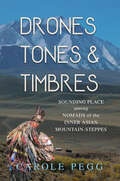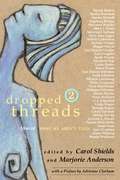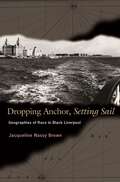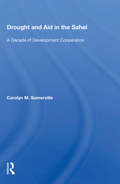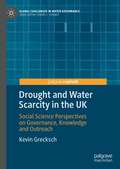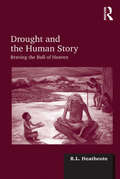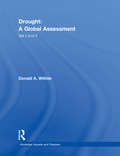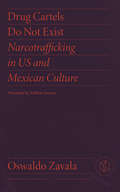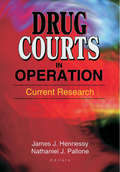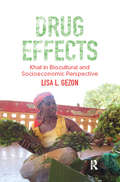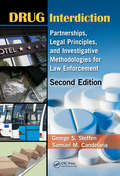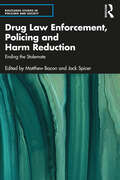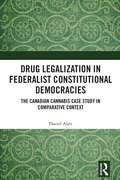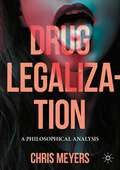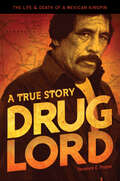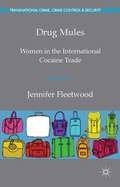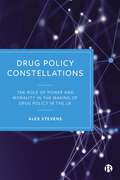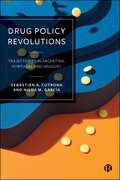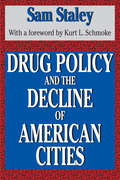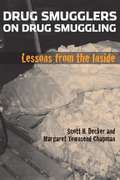- Table View
- List View
Drones and Journalism: The All Seeing Eye (Routledge Focus On Journalism Studies #4)
by Phil ChamberlainDrones and Journalism explores the increased use of unmanned aerial vehicles, or drones, by the global media for researching and newsgathering purposes. Phil Chamberlains examines the technological development and capabilities of contemporary drone hardware, whilst also exploring the use of drones in investigative reporting, in the reporting of humanitarian crisis, and the use of this new technology in more mainstream media practices. The book also analyses the complex place of the media’s drone use in relation to international laws, as well as the ethical challenges and issues raised by the practice.
Drones and the Creative Industry: Innovative Strategies for European SMEs
by Virginia Santamarina-Campos Marival Segarra-OñaThis open access, interdisciplinary book presents innovative strategies in the use of civil drones in the cultural and creative industry. Specially aimed at small and medium-sized enterprises (SMEs), the book offers valuable insights from the fields of marketing, engineering, arts and management. With contributions from experts representing varied interests throughout the creative industry, including academic researchers, software developers and engineers, it analyzes the needs of the creative industry when using civil drones both outdoors and indoors. The book also provides timely recommendations to the industry, as well as guidance for academics and policymakers.
Drones in Society: New Visual Aesthetics (Social Visualities)
by Elisa SerafinelliThis book explores the evolving world of drones through a multifaceted lens, revealing their profound impact on society and visual culture. The comprehensive collection bridges the gap between technology and aesthetics, dissecting the transformative role drones play in various domains, from cinema and art to surveillance and environmental sensing. Each chapter, penned by leading scholars, explores the unique ways drones are redefining our visual landscape, whether in capturing unprecedented cinematic shots, aiding in critical rescue missions, or offering new perspectives in artistic endeavours. The book is an essential read for academics, professionals, and enthusiasts alike, and is a key resource for anyone seeking to comprehend the full spectrum of drone capabilities and their implications for the future of visual communication and technology. Chapter 2 is available open access under a Creative Commons Attribution 4.0 International License via link.springer.com.
Drones, Tones, and Timbres: Sounding Place among Nomads of the Inner Asian Mountain-Steppes
by Carole PeggAn indispensable study of the music of Altai-Sayan peoples Based on more than twenty years of collaborative research, Carole Pegg’s long-awaited participatory ethnography explores how Indigenous nomadic peoples of Russia’s southern Siberian republics (Altai, Khakassia, Tyva) sound multiphonies of place in a post-Soviet global world. Inspired by the mountain-steppe ecology and pathways of nomadism, soundscapes created in performative ritual events cross political and multiple-world boundaries in a shamanic-animist universe, enabling human and spirit actor interactions in a series of sensuous worlds. As with the “throat-singing” for which Indigenous Altai-Sayan peoples are famous, senses of place involve sonic relations, rootedness, movement, and plurality. Pegg echoes their drone-partials musical and ontological models in an innovative theoretical entwinement. Three strands form the book’s multivocal drone, the partials of which sound in each chapter: ontological sonicality and musicality that enables emplacement and movement; the importance of shamanism-animism--at the core of Indigenous spiritual practices--for personhood and community; and the agency of sonic performances. Sounding place, Pegg demonstrates, is essential to the identities, ways of life, and very senses of being of Indigenous Altai-Sayan peoples.
Drop That Knowledge: Youth Radio Stories
by Elisabeth Soep Vivian ChávezThis is the first book to take us inside Youth Radio for a fascinating, behind-the-scenes look at a unique, Peabody Award-winning organization that produces distinctive content for outlets from National Public Radio to YouTube.
Dropped Threads 2: More of What We Aren't Told
by Carol Shields Marjorie AndersonThe idea for Dropped Threads: What We Aren't Told came up between Carol Shields and longtime friend Marjorie Anderson over lunch. It appeared that after decades of feminism, the "women's network" still wasn't able to prevent women being caught off-guard by life. There remained subjects women just didn't talk about, or felt they couldn't talk about. Holes existed in the fabric of women's discourse, and they needed examining.They asked thirty-four women to write about moments in life that had taken them by surprise or experiences that received too little discussion, and then they compiled these pieces into a book. It became an instant number one bestseller, a book clubs' favourite and a runaway success. Dropped Threads, says Anderson, "tapped into a powerful need to share personal stories about life's defining moments of surprise and silence." Readers recognized themselves in these honest and intimate stories; there was something universal in these deeply personal accounts. Other stories and suggestions poured in. Dropped Threads would clearly be an ongoing project.Like the first volume, Dropped Threads 2 features stories by well-known novelists and journalists such as Jane Urquhart, Susan Swan and Shelagh Rogers, but also many excellent new writers including teachers, mothers, a civil servant, a therapist. This triumphant follow-up received a starred first review in Quill and Quire magazine, which called it "compassionate and unflinching." The book deals with such difficult topics as loss, depression, disease, widowhood, violence, and coming to terms with death. Several stories address some of the darker sides of motherhood:- A mother describes how, while sleep-deprived and in a miserable marriage, she is shocked to find infanticide crossing her mind.- Another woman recounts a memory of her alcoholic mother demanding the children prove their loyalty in a terrifying way.- A woman desperate for children refers to the bleak truth as: "Another Christmas of feeling barren." Narrating the fertility treatment she undergoes, the hopes dashed, she is amusing in retrospect and yet brutally honest.While they deal with loss and trauma, the pieces show the path to some kind of acceptance, showing the authors' determination to learn from pain and pass on the wisdom gained. The volume also covers the rewards of learning to be a parent, choosing to remain single, or fitting in as a lesbian parent. It explores how women feel when something is missing in a friendship, how they experience discrimination, relationship challenges, and other emotions less easily defined but just as close to the bone:- Alison Wearing in "My Life as a Shadow" subtly describes allowing her personality to be subsumed by her boyfriend's.- Pamela Mala Sinha tells how, after suffering a brutal attack, she felt self-hatred and a longing for retribution.- Dana McNairn talks of her uncomfortable marriage to a man from a different social background: "I wanted to fit in with this strange, wondrous family who never raised their voices, never swore and never threw things at one another."Humour, a confiding tone, and beautiful writing elevate and enliven even the darkest stories. Details bring scenes vividly to life, so we feel we are in the room with Barbara Defago when the doctor tells her she has breast cancer, coolly dividing her life into a 'before and after.' Lucid, reflective and poignant, Dropped Threads 2 is for anyone interested in women's true stories.
Dropping Anchor, Setting Sail: Geographies of Race in Black Liverpool
by Jacqueline Nassy BrownThe port city of Liverpool, England, is home to one of the oldest Black communities in Britain. Its members proudly date their history back at least as far as the nineteenth century, with the global wanderings and eventual settlement of colonial African seamen. Jacqueline Nassy Brown analyzes how this worldly origin story supports an avowedly local Black politic and identity--a theme that becomes a window onto British politics of race, place, and nation, and Liverpool's own contentious origin story as a gloriously cosmopolitan port of world-historical import that was nonetheless central to British slave trading and imperialism. This ethnography also examines the rise and consequent dilemmas of Black identity. It captures the contradictions of diaspora in postcolonial Liverpool, where African and Afro-Caribbean heritages and transnational linkages with Black America both contribute to and compete with the local as a basis for authentic racial identity. Crisscrossing historical periods, rhetorical modes, and academic genres, the book focuses singularly on "place," enabling its most radical move: its analysis of Black racial politics as enactments of English cultural premises. The insistent focus on English culture implies a further twist. Just as Blacks are racialized through appeals to their assumed Afro-Caribbean and African cultures, so too has Liverpool--an Irish, working-class city whose expansive port faces the world beyond Britain--long been beyond the pale of dominant notions of authentic Englishness. Dropping Anchor, Setting Sail studies "race" through clashing constructions of "Liverpool."
Drought And Aid In The Sahel: A Decade Of Development Cooperation
by Carolyn M. SomervilleThe 1968-1974 drought in the Sahel was an unprecedented catastrophe for the region, causing extensive crop failures, loss of human and animal populations, political instability, and the destruction of social and cultural structures. The response of the world to the catastrophe began with food aid donations from the Western nations and led to the fo
Drought and Water Scarcity in the UK: Social Science Perspectives on Governance, Knowledge and Outreach (Global Challenges in Water Governance)
by Kevin GreckschThis book presents a social science perspective on drought and water scarcity in the UK. It puts forward a narrative of how different stakeholders manage drought and water scarcity, how they generate and manage knowledge and how power relationships between stakeholders shape drought and water scarcity management. The book begins with an analysis and critique of all water resources management plans produced by English and Welsh water supply companies for the period 2014-2019 and introduces a novel typology for drought management options. It then moves on to discuss the effect of drought and water scarcity on businesses and production processes as well as how knowledge about drought and water scarcity is generated, by whom and for what purpose. Ultimately the book argues for the urgent need to engage people in the UK about water issues and offers a novel perspective on how to communicate and engage with drought research.
Drought and the Human Story: Braving the Bull of Heaven
by R.L. HeathcoteDrought has been a long companion in the human story. Mythologised as the devastating Bull of Heaven in one of the earliest heroic legends to come out of Mesapotamia, drought has continued to wreak havoc upon societies, in many cases playing a significant role in their final demise. For societies in the 21st Century drought hovers on all horizons, the ultimate drought-proofing of society - long sought - remains elusive. This study of the human conceptualization of drought in a global setting examines the historical record from early human society through to present day concerns to explore how and why attitudes to drought have changed and why the mitigation of its impacts has become more difficult. To offer a more lasting strategy for protection against drought, the author argues that physical scientists need to combine their skills in understanding global ecology and their technological expertise with the social scientists' awareness of the socio-economic, political and cultural contexts in which modern societies operate. Both will have to ensure that their cooperative strategies for drought management will be understood and supported by the public. If this cooperation can be achieved, the future rampages of the Bull of Heaven may be contained.
Droughts: A Global Assesment (Books In Soils, Plants, And The Environment Ser. #Vol. 86)
by Donald A. WilhiteDrought draws together contributions from over 75 leading international researchers in the field to present the most comprehensive body of research on the physical and social dimensions of drought to date. Including an extensive range of case-studies covering the most drought-prone and most affected countries, the contributors examine new technology, planning methodologies and mitigation actions from recent drought experiences worldwide.Following a discussion of the critical concepts of drought, the work is divided into the following additional parts:· causes and predictability· monitoring and early warning techniques· impacts and assessment methodologies· links between drought and other global issues· conclusions and future challenges
Drug Abuse: Its Natural History and Clinical Treatment
by Marvin R. Burt Sharon Pines Thomas J. GlynnThe success or failure of drug treatment programs have long been evaluated by assessing the clients' progress while in treatment and their status upon completion. This approach does not provide a complete assessment or an adequate picture of treatment outcomes over time. A comprehensive evaluation of the success or failure of treatment should also include client status in the years following treatment for a fair assessment of the long-term efficacy of any drug-treatment program. What happens to former clients who left treatment? What influence did the treatment have on their lives? These are the questions that Marvin R. Burt seeks to answer with the follow-up studies included in this book. By selecting samples of former clients treated by two of the largest drug treatment agencies in the U.S. and control groups, Burt compares client behavior in terms of drug abuse, criminal activity, and socioeconomic productivity before, immediately following, and well after treatment. The findings in this book challenge many common assumptions about drug treatment programs. Burt finds larger than expected positive behavioral changes in clients regardless of treatment duration or type, and demographic or background characteristics. Whether the results are attributable to the clients' maturation, commitment to change, or a reduction in the availability of drugs, the positive results of treatment are encouraging. This volume provides valuable insight into the natural history of drug abuse and outcomes for client groups.
Drug Cartels Do Not Exist: Narcotrafficking in US and Mexican Culture (Critical Mexican Studies)
by Oswaldo ZavalaThrough political and cultural analysis of representations of the so-called war on drugs, Oswaldo Zavala makes the case that the very terms we use to describe drug traffickers are a constructed subterfuge for the real narcos: politicians, corporations, and the military. Though Donald Trump's incendiary comments and monstrous policies on the border revealed the character of a deeply depraved leader, state violence on both sides of the border is nothing new. Immigration has endured as a prevailing news topic, but it is a fixture of modern society in the neoliberal era; the future will be one of exile brought on by state violence and the plundering of our natural resources to sate capitalist greed. Yet the realities of violence in Mexico and along the border are obscured by the books, films, and TV series we consume. In truth, works like Sicario, The Queen of the South, and Narcos hide Mexico's political realities. Alongside these examples, Zavala discusses Charles Bowden, 2666 by Roberto Bolaño, and other important Latin American writers as examples of those who do capture the realities of the drug war. Translated into English by William Savinar, Drug Cartels Do Not Exist will be useful for journalists, political scientists, philosophers, and writers of any kind who wish to break down the constructed barriers—physical and mental—created by those in power around the reality of the Mexican drug trade.
Drug Courts in Operation: Current Research
by James Joseph HennessyExamine an innovative strategy for fighting the war on drugs!Drug Courts in Operation: Current Research provides an in-depth look at an increasingly utilized approach to rehabilitating substance abusers. Drug courts offer their participants a chance to better themselves by providing support and structure to those that do not have it in their life, offering substance abusers a chance to participate in rehabilitation in lieu of incarceration. This insightful book examines the history of drug courts as a principal treatment alternative to incarceration, outlines the risk factors of children living with drug-addicted parents, and introduces a program to help strengthen families.The book delivers vital information on: introducing programs to help prevent narcotic use by children with drug-addicted parents the need for cultural- and gender-specific treatment plans, especially in the treatment of women and African-American males treatment dosage effects the importance of length of participation to outcomes focus groups designed to help drug court participants with their employment needs predictors of engagement in court-mandated treatment programs how legal coercion of high-risk patients via the threat of incarceration motivates participants to succeed
Drug Effects: Khat in Biocultural and Socioeconomic Perspective (Advances in Critical Medical Anthropology)
by Lisa GezonKhat, marijuana, peyote—are these dangerous drugs or vilified plants with rich cultural and medical values? In this book, Lisa Gezon brings the drug debate into the 21st century, proposing criteria for evaluating psychotropic substances. Focusing on khat, whose bushy leaves are an increasingly popular stimulant and the target of vehement anti-drug campaigns, she explores biocultural and socioeconomic contexts on local, national, and global levels. Gezon provides a multidisciplinary examination of the plant’s direct physical and psychological effects, as well as indirect social and structural effects on income and labor productivity, identity, gendered relationships, global drug discourses, and food security. This sophisticated, multi-leveled analysis cuts through the traditional battle lines of the drug debate and is a model for understanding and evaluating psychotropic substances around the world.
Drug Interdiction: Partnerships, Legal Principles, and Investigative Methodologies for Law Enforcement, Second Edition
by George S. Steffen Samuel M. CandelariaAs drug trafficking and the abuse of illicit drugs continue to inflict untold harm upon our society, it is clear that a global initiative and an intense domestic strategy are vital to address the sophisticated drug trafficking organizations (DTOs) that are prevalent in many regions. Covering a wide array of domestic interdiction topics, Drug Interd
Drug Law Enforcement, Policing and Harm Reduction: Ending the Stalemate (Routledge Studies in Policing and Society)
by Matthew Bacon and Jack SpicerThe policing of drugs is an intriguing, complex, and contentious domain that brings into sharp focus the multifaceted nature of the police role and has farreaching consequences for health, crime, and justice. While research on drugs policing has historically been surprisingly sparse, fragmented, and underdeveloped, the field has recently become a burgeoning area of academic study, influenced by contemporary trends in policing practices, changes in drug policy, and wider social movements. This book makes a much-needed interdisciplinary and international contribution that engages with established and emerging areas of scholarship, advances cutting-edge debates, and sets an agenda for future directions in drugs policing. Drug Law Enforcement, Policing and Harm Reduction is the first edited collection to devote its attention exclusively to drugs policing. It brings together a range of leading scholars to provide a deep and thorough account of the current state of knowledge. In addition to academic analysis, authors also include serving police officers and policymakers, who have influenced how drugs policing is framed and carried out. Together, the contributors draw on a diverse set of empirical studies and theoretical perspectives, with the thread running throughout the book being the concept of harm reduction policing. With accounts from various countries, localities, and contexts, topics covered include the (in)effectiveness and (un)intended consequences of the ‘war on drugs’, attempts to reform drugs policing, and the role of partnerships and policy networks. The broader theme of inequality lies at the heart of this collection. An accessible and compelling read, this book will be of interest to academics and students of criminology, public health, and social policy, especially those researching policing, drug policy, and harm reduction. It also offers valuable insights and practical guidance for professionals working in the drugs field.
Drug Legalization in Federalist Constitutional Democracies: The Canadian Cannabis Case Study in Comparative Context
by Daniel AlatiThis book uses the Canadian Cannabis legalization experiment, analyzed in the historical context of wider drug criminalization in Canada, and placed in international perspective, to examine important lessons about the differential implementation of federal law in jurisdictions within federalist constitutional democracies. Utilizing a socio-legal, interdisciplinary methodology, the work provides a comprehensive history of federal drug policy and engages in a critical appraisal of its provincial implementation. It also presents a significant international and comparative component, bringing in analyses of the status of drug legalization in other federalist constitutional democracies. Readers of the book will thus gain a comprehensive knowledge of drug legalization in federalist constitutional democracies. They will also better understand the political and cultural factors that impact upon differential implementation of federal law in individual jurisdictions including, but not limited to, legacies of racism and stigmatization of drug use. Using the experience of Canada and other countries, future challenges and lessons to be learned for states considering federal drug legalization are analysed and explained. The book will be a valuable resource for students, academics and policy-makers in the areas of Criminal Law, Constitutional Law, Criminology, Socio-Legal Studies, Indigenous Studies, and Drug and Health Policy Studies.
Drug Legalization: A Philosophical Analysis
by Chris MeyersThis textbook introduces students to the various arguments for and against the prohibition of recreational drugs. The arguments are carefully presented and analyzed, inviting students to consider the competing principles of liberty rights, paternalism, theories of punishment, legal moralism, and the social consequences of drug use and drug laws. Meyers extends this examination by presenting alternatives to the prohibition/legalization dichotomy, including harm reduction, decriminalization, and user licensing or on-premise use. The presentation invites readers to think clearly about the reasons and principles that should determine public policy and law, while also delving into the deeper philosophical questions underlying the drug prohibition debate. Is it morally wrong to use drugs? If so, would that be reason enough to make it illegal? Are there good reasons in favor of using illicit drugs? Do addicts lack free will, and if so, would it be unjust to punish them? What is (or ought to be) the purpose of punishment? Is the state justified in limiting the freedom of competent adults for their own good? What should be the goal of drug policy, reduced use or reduced harm?The purpose of the book is twofold. First, it is a review of the arguments for and against drug prohibition, a useful tool for policy makers, activists, and concerned citizens with an understanding of the relevant considerations for determining how we should reform our failing drug policy. Second, the book serves as a case study in the deeper issues of justice, the nature of law, rights and liberties, and the public good. Students studying applied ethics, political science, or public policy will benefit greatly from Meyers' approach.
Drug Lord: A True Story
by Charles Bowden Terrence E. Poppa"Drug Lord is the real thing. Raw, immediate, indispensable."-Don Winslow, author of The Power of Dog and California Fire and Life"The [drug smuggling] business goes on, the slaughtered dead pile up, the US agencies continue to ratchet up their budgets, the prisons grow larger and all the real rules of the game are in this book, some kind of masterpiece."-Charles Bowden, from the introduction"Pablo Acosta was a living legend in his Mexican border town of Ojinaga. He smuggled tremendous amounts of drugs into the United States; he survived numerous attempts on his power-and his life-by rivals; and he blessed the town with charity and civic improvements. He was finally slain in 1987 during a raid by Mexican officials with the cooperation of US law enforcement. Poppa has turned out a detailed and exciting book, covering in depth Acosta's life; the other drug factions that battled with him; the village of Ojinaga; and the logistics of the drug operation. The result is a nonfiction account with enough greed, treachery, shoot-outs, and government corruption to fascinate true crime and crime fiction readers alike. Highly recommended."-Library JournalTerrence E. Poppa, an award-winning journalist, was a finalist for a 1987 Pulitzer Prize for his investigations into the connection between crime and government in Mexico. He was featured in Standoff in Mexico, a PBS production about fraudulent elections in Mexico. Due to his unique insights into the world of Mexican drug trafficking, Poppa has been widely interviewed on radio and television, including Larry King Live and The O'Reilly Factor.
Drug Mules
by Jennifer FleetwoodFleetwood explores how women become involved in trafficking, focusing on the lived experiences of women as drug mules. Offering theoretical insights from gender theory and transnational criminology, Fleetwood argues that women's participation in the drugs trade cannot be adequately understood through the lenses of either victimization or agency.
Drug Policy Constellations: The Role of Power and Morality in the Making of Drug Policy in the UK
by Alex StevensHow is UK drugs policy made, and why does it so often seem irrational when considering what works in reducing drug-related harms? This book explains how the concept of drug policy constellations – the loosely concerted policy actors with shared moral commitments that influenced policy outcomes – explains why there is no such thing as 'evidence-based' drug policy. Drawing on his participation in high-level policy discussions, and a novel approach to policy analysis, Stevens presents three recent cases involving key issues in UK illicit drug policy – medical cannabis, drug-related deaths and the government’s 10-year drug strategy.
Drug Policy Revolutions: Trajectories in Argentina, Portugal, and Uruguay
by Sebastián A. Cutrona Nilda M. GarcíaCoinciding with a wave of drug policy liberalization around the world, this book analyzes the experiences of Argentina, Portugal, and Uruguay in their efforts at depenalization, decriminalization, and legalization/regulation of recreational drugs. The authors present the successes and challenges of the approaches and their impacts on drug use, public health, and security, debunking some of the myths surrounding flexible drug policies along the way. Contrasting the three liberalization cases with the criminalization approach of the US at federal level, the book offers policy recommendations and lessons learned from the historical trajectories and policy reforms in addressing drug consumption and its associated harms.
Drug Policy and the Decline of the American City
by Sam StaleyThe drug trade is a growth industry in most major American cities, fueling devastated inner-city economies with revenues in excess of $100 billion. In this timely volume, Sam Staley provides a detailed, in-depth analysis of the consequences of current drug policies, focusing on the relationship between public policy and urban economic development and on how the drug economy has become thoroughly entwined in the urban economy. The black market in illegal drugs undermines essential institutions necessary for promoting long-term economic growth, including respect for civil liberties, private property, and nonviolent conflict resolution. Staley argues that America's cities can be revitalized only through a major restructuring of the urban economy that does not rely on drug trafficking as a primary source of employment and income-the inadvertent outcome of current prohibitionist policy. Thus comprehensive decriminalization of the major drugs (marijuana, cocaine, and heroin) is an important first step toward addressing the economic and social needs of depressed inner cities. Staley demonstrates how decriminalization would refocus public policy on the human dimension of drug abuse and addiction, acknowledge that the cities face severe development problems that promote underground economic activity, and reconstitute drug policy on principles consistent with limited government as embodied in the U.S. Constitution and Bill of Rights. Designed to cross disciplinary boundaries, Staley's provocative analysis will be essential reading for urban policymakers, sociologists, economists, criminologists, and drug-treatment specialists.
Drug Smugglers on Drug Smuggling: Lessons from the Inside
by Scott H. Decker Margaret Townsend ChapmanDrug Smugglers on Drug Smuggling examines the organizational structures of drug smuggling from Colombia to the US. Career drug smugglers describe a series of often disconnected networks that enable smugglers to best organize their business in a way that will minimize the risks of apprehension and maximize profits.
